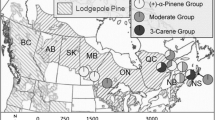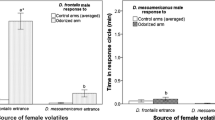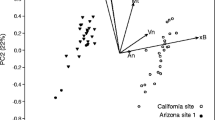Abstract
We investigated geographic variation in the semiochemistry of major disturbance agents of western North American pine forests, Dendroctonus brevicomis Le Conte and Dendroctonus barberi Hopkins (Coleoptera: Curculionidae: Scolytinae), species separated by the Great Basin in the USA that until recently were synonymous. At 15 sites in the western USA and northern Mexico, beetle populations were examined to determine (1) pheromone production by solitary, mining females, (2) male electroantennogram amplitudes in response to known semiochemicals for the genus, or (3) relative attractiveness of two female-produced pheromone components (endo- and exo-brevicomin) and two host odors (alpha-pinene and myrcene) to beetles in the field. Compared to female beetles collected east of the Great Basin (D. barberi), western females (D. brevicomis) produced a consistently higher proportion of, and male antenna were correspondingly more sensitive to, the exo- than the endo-isomer of brevicomin. With the exception of one sampling location (where no preference was observed), beetles west of the Great Basin were more attracted to exo- than endo- brevicomin trap lures, whereas eastern beetles displayed the reverse preference. In contrast, there was not a consistent difference between these populations regarding relative attraction or olfactory response to myrcene or alpha-pinene, although some geographic variability was evident. These data show that the semiochemical systems of D. brevicomis and D. barberi have diverged and corroborate genetic and morphological evidence that they are distinct, allopatric species.



Similar content being viewed by others
Notes
We do not believe that the low purity discovered for the contents of a portion of the lures would have significantly influenced the results. The contamination was due to compounds that would have had substantially lower permeability through polyethylene (i.e., oxygenated and higher molecular weight compounds) than hydrocarbon monoterpenes alpha-pinene and myrcene and thus would have been released from the lures at a considerably lower rate than the primary monoterpene component. No more than trace levels of the two monoterpenes alpha-pinene and myrcene were present in the reciprocal lure.
References
Asaro C, Sullivan BT, Dalusky MJ, Berisford CW (2004) Volatiles associated with preferred and nonpreferred hosts of the Nantucket pine tip moth, Rhyacionia frustrana. J Chem Ecol 30:977–990
Bedard WD, Tilden PE, Wood DL, Silverstein RM, Brownlee RG, Rodin JO (1969) Western pine beetle: field response to its sex pheromone and a synergistic host terpene, myrcene. Science 164:1284–1285
Bedard WD, Tilden PE, Lindahl KQ Jr, Wood DL, Rauch PA (1980a) Effects of verbenone and trans-verbenol on the response of Dendroctonus brevicomis to natural and synthetic attractant in the field. J Chem Ecol 6:997–1013
Bedard WD, Wood DL, Tilden PE, Lindahl KQ Jr, Silverstein RM, Rodin JO (1980b) Field responses of the western pine beetle and one of its predators to host- and beetle-produced compounds. J Chem Ecol 6:625–641
Berisford CW, Payne TL, Berisford YC (1990) Geographical variation in response of southern pine beetle (Coleoptera: Scolytidae) to aggregating pheromones in laboratory bioassays. Environ Entomol 19:1671–1674
Bertram SL, Paine TD (1994) Influence of aggregation inhibitors (verbenone and ipsdienol) on landing and attack behavior of Dendroctonus brevicomis (Coleoptera: Scolytidae). J Chem Ecol 20:1617–1629
Birch MC (1978) Chemical communication in pine bark beetles. Am Sci 66:409–419
Blomquist GJ, Figueroa-Teran R, Aw M, Song MM, Gorzalski A, Abbott NL, Chang E, Tittiger C (2010) Pheromone production in bark beetles. Insect Biochem Mol Biol 40:699–712
Bookwalter J, Riggins J, Dean J, Mastro V, Schimleck L, Sullivan B, Gandhi K (2019) Colonization and development of Sirex noctilio (Hymenoptera: Siricidae) in bolts of a native pine host and six species of pine grown in the southeastern United States. J Entomol Sci 54:1–18
Borden JH, Ryker LC, Chong LJ, Pierce HD Jr, Johnston BD, Oehlschlager AC (1987) Response of the mountain pine beetle, Dendroctonus ponderosae Hopkins (Coleoptera: Scolytidae), to five semiochemicals in British Columbia lodgepole pine forests. Can J For Res 17:118–128
Borden J, Gries G, Chong L, Werner R, Holsten E, Wieser H, Dixon E, Cerezke H (1996) Regionally-specific bioactivity of two new pheromones for Dendroctonus rufipennis (Kirby)(Col., Scolytidae). J Appl Entomol 120:321–326
Borden JH, Pureswaran DS, Lafontaine JP (2008) Synergistic blends of monoterpenes for aggregation pheromones of the mountain pine beetle (Coleoptera: Curculionidae). J Econ Entomol 101:1266–1275
Bracewell R, Vanderpool D, Good J, Six D (2018) Cascading speciation among mutualists and antagonists in a tree–beetle–fungi interaction. Proc Roy Soc B Biol Sci 285:20180694
Browne LE, Wood DL, Bedard WD, Silverstein RM, West JR (1979) Quantitative estimates of the western pine beetle attractive pheromone components, exo-brevicomin, frontalin, and myrcene in nature. J Chem Ecol 5:397–414
Byers JA (1982) Male-specific conversion of the host plant compound, myrcene, to the pheromone, (+)- ipsdienol, in the bark beetle, Dendroctonus brevicomis. J Chem Ecol 8:363–371
Byers JA (1983) Influence of sex, maturity and host substances on pheromones in the guts of the bark beetles, Ips paraconfusus and Dendroctonus brevicomis. J Insect Physiol 29:5–13
Byers JA (1989) Chemical ecology of bark beetles. Experientia 45:271–283
Byers JA (1995) Host tree chemistry affecting colonization in bark beetles. In: Cardé RT, Bell WJ (eds) Chemical ecology of insects 2. Chapman and Hall, New York, pp 154–213
Byers J (2007) Chemical ecology of bark beetles in a complex olfactory landscape. In: Lieutier F, Day KR, Battisti A, Gregoire JC, Evans HF (eds) Bark and wood boring insects in living trees in Europe, a synthesis. Kluwer Academic Publishers, Dordrecht, pp 89–134
Byers JA, Zhang Q (2011) Chemical ecology of bark beetles in regard to search and selection of host trees. In: Liu T, Kang L (eds) Recent advances in entomological research. Springer, Heidelberg, pp 150–190
Byers JA, Wood DL, Craig J, Hendry LB (1984) Attractive and inhibitory pheromones produced in the bark beetle, Dendroctonus brevicomis, during host colonization: Regulation of inter- and intraspecific competition. J Chem Ecol 10:861–877
Cale JA, Taft S, Najar A, Klutsch JG, Hughes CC, Sweeney JD, Erbilgin N (2016) Mountain pine beetle (Dendroctonus ponderosae) can produce its aggregation pheromone and complete brood development in naïve red pine (Pinus resinosa) under laboratory conditions. Can J For Res 45:1873–1877
Chapman JA (1963) Field selection of different log odors by scolytid beetles. Can Entomol 95:673–676
Clark EL, Pitt C, Carroll AL, Lindgren BS, Huber DP (2014) Comparison of lodgepole and jack pine resin chemistry: implications for range expansion by the mountain pine beetle, Dendroctonus ponderosae (Coleoptera: Curculionidae). Peer J 2:e240
Davis T, Hofstetter R (2012) Plant secondary chemistry mediates the performance of a nutritional symbiont associated with a tree-killing herbivore. Ecology 93:421–429
Davis T, Hofstetter R, Klepzig K, Foster J, Keim P (2010) Interactions between multiple fungi isolated from two bark beetles, Dendroctonus brevicomis and Dendroctonus frontalis (Coleoptera: Curculionidae). J Yeast Fungal Res 1:118–126
Erbilgin N, Powell JS, Raffa KF (2003) Effect of varying monoterpene concentrations on the response of Ips pini (Coleoptera: Scolytidae) to its aggregation pheromone: Implications for pest management and ecology of bark beetles. Agric For Entomol 5:269–274
Fettig CJ, Borys RR, Cluck DR, Smith SL (2004) Field response of Dendroctonus valens (Coleoptera: scolytidae) and a major predator, Temnochila chlorodia (Coleoptera: Trogositidae), to host kairomones and a Dendroctonus spp. pheromone component. J Entomol Sci 39:490–499
Fettig CJ, Mortenson LA, Bulaon BM, Foulk PB (2019) Tree mortality following drought in the central and southern Sierra Nevada, California, US. For Ecol Manag 432:164–178
Gitau C, Bashford R, Carnegie A, Gurr G (2013) A review of semiochemicals associated with bark beetle (Coleoptera: Curculionidae: Scolytinae) pests of coniferous trees: a focus on beetle interactions with other pests and their associates. For Ecol Manag 297:1–14
Gries G, Leufvén A, Lafontaine J, Pierce H, Borden J, Vanderwel D, Oehlschlager A (1990) New metabolites of α-pinene produced by the mountain pine beetle, Dendroctonus ponderosae (Coleoptera: Scolytidae). Insect Biochem 20:365–371
Hobson KR, Wood DL, Cool LG, White PR, Ohtsuka T, Kubo I, Zavarin E (1993) Chiral specificity in responses by the bark beetle Dendroctonus valens to host kairomones. J Chem Ecol 19:1837–1846
Hofstetter RW, Chen Z, Gaylord ML, McMillin JD, Wagner MR (2008) Synergistic effects of alpha-pinene and exo-brevicomin on pine bark beetles and associated insects in Arizona. J Appl Entomol 132:387–397
Hofstetter RW, Gaylord ML, Martinson S, Wagner MR (2012) Attraction to monoterpenes and beetle-produced compounds by syntopic Ips and Dendroctonus bark beetles and their predators. Agric For Entomol 14:207–215
Hopkins AD (1909) Contributions toward a monograph of scolytid beetles. I. Bark beetles of the genus Dendroctonus. US Dept Agrie Bur Ent Tech Ser 17:1-164
Hughes PR (1973) Dendroctonus: production of pheromones and related compounds in response to host monoterpenes. Z Angew Entomol 73:294–312
Hughes PR, Renwick JAA, Vité JP (1976) The identification and field bioassay of chemical attractants in the roundheaded pine beetle. Environ Entomol 5:1165–1168
Kelley ST, Farrell BD (1998) Is specialization a dead end? The phylogeny of host use in Dendroctonus bark beetles (Scolytidae). Evolution 52:1731–1743
Kelley ST, Mitton JB, Paine TD (1999) Strong differentiation in mitochondrial DNA of Dendroctonus brevicomis (Coleoptera: Scolytidae) on different subspecies of ponderosa pine. Ann Entomol Soc Am 92:193–197
Lanier GN, Birch MC, Schmitz RF, Furniss MM (1972) Pheromones of Ips pini (Coleoptera: Scolytidae): variation in response among three populations. Can Entomol 104:1917–1923
Lanier GN, Hendrichs JP, Flores JE (1988) Biosystematics of the Dendroctonus frontalis (Coleoptera: Scolytidae) complex. Ann Entomol Soc Am 81:403–418
Libbey LM, Morgan ME, Putnam TB, Rudinsky JA (1974) Pheromones released during inter- and intra-sex response of the scolytid beetle Dendroctonus brevicomis. J Insect Physiol 20:1667–1671
Liu ZD, Wang B, Xu BB, Sun JH (2011) Monoterpene variation mediated attack preference evolution of the bark beetle Dendroctonus valens. PLoS One 6:e22005
Miller DR, Borden JH (2000) Dose-dependent and species-specific responses of pine bark beetles (Coleoptera: Scolytidae) to monoterpenes in association with pheromones. Can Entomol 132:183–195
Miller DR, Borden JH, Slessor KN (1996) Enantiospecific pheromone production and response profiles for populations of pine engraver, Ips pini (Say) (Coleoptera: Scolytidae), in British Columbia. J Chem Ecol 22:2157–2172
Mirov NT (1961) Composition of gum turpentines of pines. USDA Forest Service Pacific Southwest Forest Range Experiment Station Technical Bulletin 1239:1–25
Munro H, Gandhi K, Barnes B, Montes C, Nowak J, Shepherd W, Villari C, Sullivan B (2020) Electrophysiological and behavioral responses Dendroctonus frontalis and D. terebrans (Coleoptera: Curculionidae) to resin odors of host pines (Pinus spp.). Chemoecology https://doi.org/10.1007/s00049-020-00311-7:1-17
Niño-Domínguez A, Sullivan BT, López-Urbina JH, Macías-Sámano JE (2015) Pheromone-mediated mate location and discrimination by two syntopic sibling species of Dendroctonus bark beetles in Chiapas, Mexico. J Chem Ecol 41:746–756
Niño-Domínguez A, Sullivan BT, López-Urbina JH, Macías-Sámano JE (2016) Responses by Dendroctonus frontalis and Dendroctonus mesoamericanus (Coleoptera: Curculionidae) to semiochemical lures in Chiapas, Mexico: Possible roles of pheromones during joint host attacks. J Econ Entomol 50:129–193
Økland B, Skarpaas O, Kausrud K (2009) Threshold facilitations of interacting species. Popul Ecol 51:513–523
Pitman G, Vité J (1971) Predator-prey response to western pine beetle attractants. J Econ Entomol 64:402–404
Pitman GB, Vité JP, Kinzer GW, Fentiman AF Jr (1969) Specificity of population-aggregating pheromones in Dendroctonus. J Insect Physiol 15:363–366
Potter KM, Hipkins VD, Mahalovich MF, Means RE (2015) Nuclear genetic variation across the range of ponderosa pine (Pinus ponderosa): Phylogeographic, taxonomic and conservation implications. Tree Genet Genomes 11:38
Pureswaran DS, Borden JH (2003) Test of semiochemical mediated host specificity in four species of tree killing bark beetles (Coleoptera: Scolytidae). Environ Entomol 32:963–969
Pureswaran DS, Borden JH (2005) Primary attraction and kairomonal host discrimination in three species of Dendroctonus (Coleoptera: Scolytidae). Agric For Entomol 7:219–230
Pureswaran DS, Gries R, Borden JH (2004) Quantitative variation in monoterpenes in four species of conifers. Biochem Syst Ecol 32:1109–1136
Pureswaran DS, Hofstetter RW, Sullivan BT (2008) Attraction of the southern pine beetle, Dendroctonus frontalis, to pheromone components of the western pine beetle, Dendroctonus brevicomis (Coleoptera: Curculionidae: Scolytinae), in an allopatric zone. Environ Entomol 37:70–78
Pureswaran DS, Hofstetter RW, Sullivan BT, Potter KA (2016a) The role of multimodal signals in species recognition between tree-killing bark beetles in a narrow sympatric zone. Environ Entomol 45:582–591
Pureswaran DS, Hofstetter RW, Sullivan BT, Grady AM, Brownie C (2016b) Western pine beetle populations in Arizona and California differ in the composition of their aggregation pheromones. J Chem Ecol 42:404–413
Raffa KF (2001) Mixed messages across multiple trophic levels: The ecology of bark beetle chemical communication systems. Chemoecology 11:49–65
Raffa KF (2014) Terpenes tell different tales at different scales: glimpses into the chemical ecology of conifer-bark beetle-microbial interactions. J Chem Ecol 40:1–20
Renwick JAA (1976) Selective production of cis- and trans- verbenol from (-)- and (+)-α-pinene by a bark beetle. Science 191:199–201
Renwick JAA, Hughes PR (1975) Oxidation of unsaturated cyclic hydrocarbons by Dendroctonus frontalis. Insect Biochem 5:459–463
Renwick JAA, Vité JP (1970) Systems of chemical communication in Dendroctonus. Contrib Boyce Thompson Inst 24:283–292
Seybold SJ, Huber DPW, Lee JC, Graves AD, Bohlmann J (2006) Pine monoterpenes and pine bark beetles: a marriage of convenience for defense and chemical communication. Phytochem Rev 5:143–178
Silverstein RM, Brownlee RG, Bellas TE, Wood DL, Browne LE (1968) Brevicomin: principal sex attractant in the frass of the female western pine beetle. Science 159:889–891
Six D, Bracewell R (2015) Dendroctonus. In: Vega FE, Hofstetter RW (eds) Bark beetles: biology and ecology of native and invasive species. Academic, Cambridge, pp 305–350
Skillen EL, Berisford CW, Camaan MA, Reardon RC (1997) Semiochemicals of forest and shade tree insects in North America and management applications. USDA Forest Service Forest Health Technology Enterprise Team Publication FHTET-96-15, pp 182
Smith RH (1977) Monoterpenes of ponderosa pine xylem resin in western United States. U S Dept Agri Tech Bull 1532, pp 48
Smith RH (2000) Xylem monoterpenes of pines: distribution, variation, genetics, function. USDA Forest Service General Technical Report PSW-GTR-177, pp 454
Staeben JC, Sullivan BT, Nowak JT, Gandhi KJ (2015) Enantiospecific responses of southern pine beetle (Dendroctonus frontalis) and its clerid predator, Thanasimus dubius, to α-pinene. Chemoecology 25:73–83
Sturgeon KB (1979) Monoterpene variation in ponderosa pine xylem resin related to western pine beetle predation. Evolution 33:803–814
Sullivan BT (2005) Electrophysiological and behavioral responses of Dendroctonus frontalis (Coleoptera: Curculionidae) to volatiles isolated from conspecifics. J Econ Entomol 98:2067–2078
Sullivan BT, Shepherd WP, Pureswaran DS, Tashiro T, Mori K (2007) Evidence that (+)-endo-brevicomin is a male-produced component of the southern pine beetle aggregation pheromone. J Chem Ecol 33:1510–1527
Sullivan BT, Niño A, Moreno B, Brownie C, Macías-Sámano J, Clarke SR, Kirkendall LR, Zúñiga G (2012) Biochemical evidence that Dendroctonus frontalis consists of two sibling species in Belize and Chiapas, Mexico. Ann Entomol Soc Am 105:817–831
Symonds MRE, Elgar MA (2004a) The mode of pheromone evolution: evidence from bark beetles. Proc Roy Soc Lond B Bio 271:839–846
Symonds MRE, Elgar MA (2004b) Species overlap, speciation and the evolution of aggregation pheromones in bark beetles. Ecol Lett 7:202–212
Taft S, Najar A, Erbilgin N (2015) Pheromone production by an invasive bark beetle varies with monoterpene composition of its naïve host. J Chem Ecol 41:540–549
Valerio-Mendoza O, Armendáriz-Toledano F, Cuéllar-Rodríguez G, Negrón JF, Zúñiga G (2017) The current status of the distribution range of the western pine beetle, Dendroctonus brevicomis (Curculionidae: Scolytinae) in northern Mexico. J Insect Sci 17:92
Valerio-Mendoza O, García-Román J, Becerril M, Armendáriz-Toledano F, Cuéllar-Rodríguez G, Negrón J, Sullivan BT, Zúñiga G (2019) Cryptic species discrimination in western pine beetle, Dendroctonus brevicomis LeConte (Curculionidae: Scolytinae), based on morphological characters and geometric morphometrics. Insects 10:377
Vité JP (1970) Pest management systems using synthetic pheromones. Contrib Boyce Thompson Inst 24:343–350
Vité JP, Francke W (1976) The aggregation pheromones of bark beetles: Progress and problems. Naturwissenschaften 63:550–555
Vité JP, Pitman GB (1969) Aggregation behaviour of Dendroctonus brevicomis in response to synthetic pheromones. J Insect Physiol 15:1617–1622
White PR, Hobson KR (1993) Stereospecific antennal response by red turpentine beetle, Dendroctonus valens, to chiral monoterpenes from ponderosa pine resin. J Chem Ecol 19:2193–2202
Willyard A, Gernandt DS, Potter K, Hipkins V, Marquardt P, Mahalovich MF, Langer SK, Telewski FW, Cooper B, Douglas C (2017) Pinus ponderosa: A checkered past obscured four species. Am J Bot 104:161–181
Wood SL (1963) A revision of the bark beetle genus Dendroctonus Erichson (Coleoptera: Scolytidae). Great Basin Nat 23:1–117
Wood SL (1982) The bark and ambrosia beetles of North and Central America (Coleoptera: Scolytidae), a taxonomic monograph. Great Basin Nat Mem 6:1359
Wood DL, Browne LE, Ewing B, Lindahl K, Bedard WD, Tilden PE, Mori K, Pitman GB, Hughes PR (1976) Western pine beetle: specificity among enantiomers of male and female components of an attractant pheromone. Science 192:896–898
Zhang QH, Schlyter F (2004) Olfactory recognition and behavioural avoidance of angiosperm nonhost volatiles by conifer-inhabiting bark beetles. Agric For Entomol 6:1–19
Acknowledgements
This publication is dedicated to the memory of Dr. Sheryl Costello of the US Forest Service who was part of the team that initiated this research project. JoAnne P. Barrett at USFS-SRS Pineville, Louisiana assisted with insect sample identification/sorting; Nick Aflitto and Stefano Padilla at Northern Arizona University assisted with trap collection as well as insect identification and counting. Douglas Robison with the Fishlake National Forest, Utah collected live insects on the Fillmore district. Philip J. Mocettini and Dick Halsey with USFS-FHP Boise Field Office assisted with collections on the Boise National Forest. Cayenne Engel of the Nevada Division of Forestry performed the trapping test in, and provided experimental insects from, the Spring Mountain National Recreation area. The Nature Conservancy graciously allowed access to the Davis Mountains Preserve.
Author information
Authors and Affiliations
Corresponding author
Rights and permissions
About this article
Cite this article
Sullivan, B.T., Grady, A.M., Hofstetter, R.W. et al. Evidence for Semiochemical Divergence Between Sibling Bark Beetle Species: Dendroctonus brevicomis and Dendroctonus barberi. J Chem Ecol 47, 10–27 (2021). https://doi.org/10.1007/s10886-020-01233-y
Received:
Revised:
Accepted:
Published:
Issue Date:
DOI: https://doi.org/10.1007/s10886-020-01233-y




